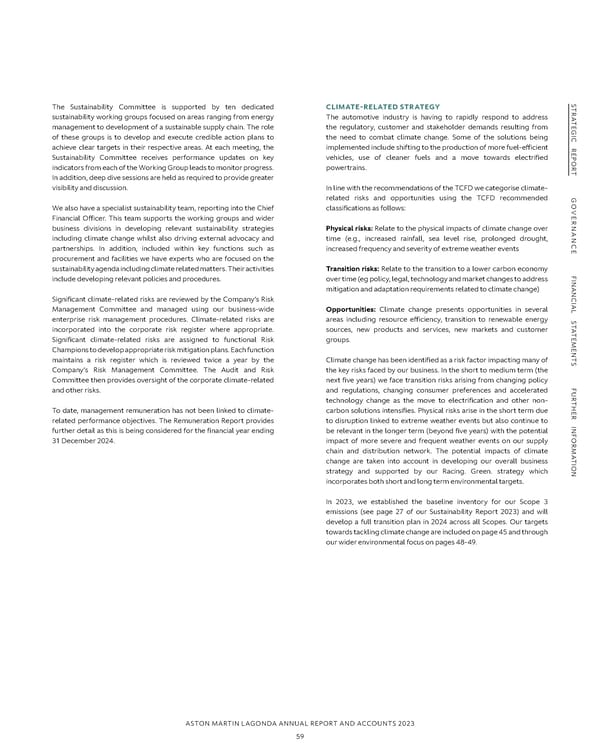S S TR The Sustainability Committee is supported by ten dedicated CLIMATE-RELATED STRATEGY TR A sustainability working groups focused on areas ranging from energy The automotive industry is having to rapidly respond to address A TE management to development of a sustainable supply chain. The role the regulatory, customer and stakeholder demands resulting from TE G G I I C of these groups is to develop and execute credible action plans to the need to combat climate change. Some of the solutions being C R achieve clear targets in their respective areas. At each meeting, the R implemented include shifting to the production of more fuel-efÏcient E E P Sustainability Committee receives performance updates on key vehicles, use of cleaner fuels and a move towards electrified P O O R indicators from each of the Working Group leads to monitor progress. powertrains. R T In addition, deep dive sessions are held as required to provide greater T visibility and discussion. In line with the recommendations of the TCFD we categorise climate- G related risks and opportunities using the TCFD recommended G O O VE We also have a specialist sustainability team, reporting into the Chief classifications as follows: VE R Financial OfÏcer. This team supports the working groups and wider R NAN business divisions in developing relevant sustainability strategies Physical risks: Relate to the physical impacts of climate change over NAN including climate change whilst also driving external advocacy and time (e.g., increased rainfall, sea level rise, prolonged drought, C C E partnerships. In addition, included within key functions such as increased frequency and severity of extreme weather events E procurement and facilities we have experts who are focused on the sustainability agenda including climate related matters. Their activities Transition risks: Relate to the transition to a lower carbon economy F F I include developing relevant policies and procedures. over time (eg policy, legal, technology and market changes to address I NAN NAN mitigation and adaptation requirements related to climate change) C Significant climate-related risks are reviewed by the Company’s Risk C IAL Management Committee and managed using our business-wide Opportunities: Climate change presents opportunities in several IAL S enterprise risk management procedures. Climate-related risks are S areas including resource efÏciency, transition to renewable energy T T A incorporated into the corporate risk register where appropriate. sources, new products and services, new markets and customer A T T E Significant climate-related risks are assigned to functional Risk E M groups. M E Champions to develop appropriate risk mitigation plans. Each function E N N T maintains a risk register which is reviewed twice a year by the Climate change has been identified as a risk factor impacting many of T S Company’s Risk Management Committee. The Audit and Risk the key risks faced by our business. In the short to medium term (the S Committee then provides oversight of the corporate climate-related next five years) we face transition risks arising from changing policy F F U and other risks. and regulations, changing consumer preferences and accelerated U R R T technology change as the move to electrification and other non- T H H E To date, management remuneration has not been linked to climate- carbon solutions intensifies. Physical risks arise in the short term due E R R INF related performance objectives. The Remuneration Report provides to disruption linked to extreme weather events but also continue to INF further detail as this is being considered for the financial year ending be relevant in the longer term (beyond five years) with the potential OR 31 December 2024. impact of more severe and frequent weather events on our supply OR M chain and distribution network. The potential impacts of climate M A A T change are taken into account in developing our overall business T I I ON strategy and supported by our Racing. Green. strategy which ON incorporates both short and long term environmental targets. In 2023, we established the baseline inventory for our Scope 3 emissions (see page 27 of our Sustainability Report 2023) and will develop a full transition plan in 2024 across all Scopes. Our targets towards tackling climate change are included on page 45 and through our wider environmental focus on pages 48-49. ASTON MARTIN LAGONDA ANNUAL REPORT AND ACCOUNTS 2023 59
 Annual Report and Accounts Page 60 Page 62
Annual Report and Accounts Page 60 Page 62